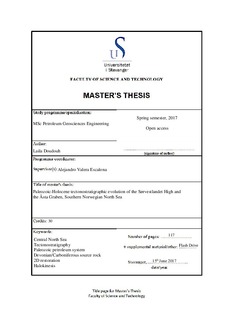| dc.contributor.advisor | Escalona, Alejandro | |
| dc.contributor.author | Doudouh, Laila | |
| dc.date.accessioned | 2017-11-07T09:06:27Z | |
| dc.date.available | 2017-11-07T09:06:27Z | |
| dc.date.issued | 2017-06-15 | |
| dc.identifier.uri | http://hdl.handle.net/11250/2464470 | |
| dc.description | Master's thesis in Petroleum Geosciences Engineering | nb_NO |
| dc.description.abstract | This study is presenting a three-dimensional seismic data set and published data from exploration wells which were used to reconstruct the tectonostratigraphic evolution of the Sørvestlandet High, Southern North Sea, Norway. The Sørvestlandet High is a southeast-northwest trending elongated Upper Jurassic horst. Four sub-salt fault families and four supra-salt families were recognized. The sub-salt fault families that are interpreted are: (1) a north-northwest-south-southwest striking fault family, (2) a northeast-southwest striking fault family, (3) an east-northeast-west-southwest striking fault family, (4) a north-northeast-south-southwest. The supra-salt faults that are interpreted are: (5) a northwest-southeast striking fault family, (6) a north-northwest-west-south-southeast striking fault family, (7) an east-west striking fault family, (8) north-northeast-south-southwest striking fault family.
Eight chronostratigraphic sequences defined by well and three-dimensional seismic data are interpreted and mapped: Devonian rifting in a sandy/lacustrine environment; Carboniferous late rifting to post-rifting lacustrine environment; Lower Permian pre-rift in a continental environment; Upper Permian rifting and deposition of the Zechstein salt; Triassic/Jurassic intracratonic setting and salt mobilization; Cretaceous flooding and chalk deposition; Lower Cenozoic and Upper Cenozoic progradation and basin margin uplift.
Similar to the Upper Jurassic Mandal High and Utsira High, where several hydrocarbon discoveries have been made, the Sørvestlandet High might consist of three petroleum plays, Devonian/Carboniferous sourced fractured and weathered crystalline basement, Devonian sands, and Lower Permian aeolian sands, with the Upper Permian salt sealing it. These three petroleum systems introduce a new possible future of hydrocarbon exploration in the Southern North Sea. | nb_NO |
| dc.language.iso | eng | nb_NO |
| dc.publisher | University of Stavanger, Norway | nb_NO |
| dc.relation.ispartofseries | Masteroppgave/UIS-TN-IPT/2017; | |
| dc.subject | petroleumsteknologi | nb_NO |
| dc.subject | petroleum engineering | nb_NO |
| dc.subject | Central North Sea | nb_NO |
| dc.subject | Devonian/Carboniferous source rock | nb_NO |
| dc.subject | 2D restoration | nb_NO |
| dc.subject | tectonostratigraphy | nb_NO |
| dc.subject | petroleumsgeologi | nb_NO |
| dc.subject | paleozoic petroleum system | nb_NO |
| dc.subject | halokinesis | nb_NO |
| dc.title | Paleozoic-Holocene tectonostratigraphic evolution of the Sørvestlandet High and the Åsta Graben, Southern Norwegian North Sea | nb_NO |
| dc.type | Master thesis | nb_NO |
| dc.subject.nsi | VDP::Teknologi: 500::Berg‑ og petroleumsfag: 510::Geoteknikk: 513 | nb_NO |
| dc.subject.nsi | VDP::Matematikk og Naturvitenskap: 400::Geofag: 450::Petroleumsgeologi og -geofysikk: 464 | nb_NO |
